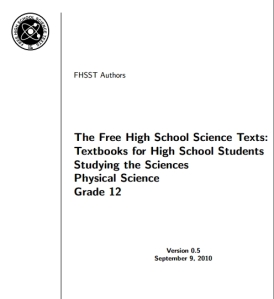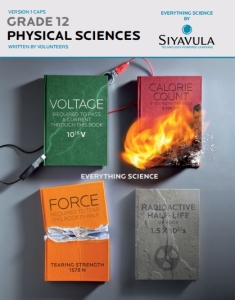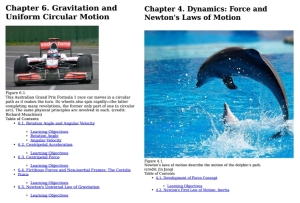10 High School Physics and Physical Science Text Books
Here are 10 excellent and well written high school Physics and Physical Science text books that teach and demonstrate many topics and areas. These all have nicely illustrated graphics and images, along with internet links to supplemental content. Physics is the study of the world around us. In a sense, we are more qualified to do physics than any other science. From the day we are born, we study the things around us in an effort to understand how they work and relate to each other. Learning how to catch or throw a ball is a physics undertaking, for example.
The best approach to physics is to relate everything you learn to things you have already noticed in your everyday life. We attempt to describe things through simple rules and mathematics, which is merely the language we use. You can start by asking a simple question like ”Why is the sky blue?” which could lead you to electromagnetic waves, which in turn could lead you to wave particle duality and to energy levels of atoms. Before long you are studying quantum mechanics or the structure of the universe. For more free physical science materials, also check out Free Physics Textbooks for Middle School, High School, and College and Over 200 Physics and Engineering Activities, Lessons, and Units (Grades 3-HS), and our other physical science learning pages on bestedlessons.
10 High School Physics Textbooks
AP Physics 1, OpenStax, with selected answers (869 pgs, mb)
College Physics For AP Courses, OpenStax, with selected answers (3,752 pgs, 32.4mb)
High School Physics, OpenStax (705 pgs, 14mb)
College Physics for High School AP Courses, OpenStax (1,694 pgs, 33mb)
College Physics 1, OpenStax (631 pgs, 12mb)
The five similar OpenStax texts above teach with real-world examples to help students grasp fundamental physics concepts. Knowledge of algebra and some trigonometry is needed, but not calculus. They include learning objectives, concept questions, links to labs and simulations, and practice opportunities for traditional physics application problems.
Topics Covered:
- The Nature of Science and Physics
- Kinematics
- Two-Dimensional Kinematics
- Dynamics: Force and Newton’s Laws of Motion
- Further Applications of Newton’s Laws: Friction, Drag, and Elasticity
- Uniform Circular Motion and Gravitation
- Work, Energy, and Energy Resources
- Linear Momentum and Collisions
- Statics and Torque
- Rotational Motion and Angular Momentum
- Fluid Statics
- Fluid Dynamics and Its Biological and Medical Applications
- Temperature, Kinetic Theory, and the Gas Laws
- Heat and Heat Transfer Methods
- Thermodynamics
- Oscillatory Motion and Waves
- Physics of Hearing
- Electric Charge and Electric Field
- Electric Potential and Electric Field
- Electric Current, Resistance, and Ohm’s Law
- Circuits and DC Instruments
- Magnetism
- Electromagnetic Induction, AC Circuits, and Electrical Technologies
- Electromagnetic Waves
- Geometric Optics
- Vision and Optical Instruments
- Wave Optics
- Special Relativity
- Introduction to Quantum Physics
- Atomic Physics
- Radioactivity and Nuclear Physics
- Medical Applications of Nuclear Physics
- Particle Physics
- Frontiers of Physics
Physics Textbook, Grades 10-12 (700 pgs, 4.6mb)

- What is Physics – Grade 10
- Units – Grade 10
- Motion in One Dimension – Grade 10
- Gravity and Mechanical Energy – Grade 10
- Transverse Pulses – Grade 10
- Transverse Waves – Grade 10
- Geometrical Optics – Grade 10
- Magnetism – Grade 10
- Electrostatics – Grade 10
- Electric Circuits – Grade 10
- Vectors – Grade 11
- Force, Momentum and Impulse – Grade 11
- Geometrical Optics – Grade 11
- Longitudinal Waves – Grade 11
- Sound – Grade 11
- The Physics of Music – Grade 11
- Electromagnetism – Grade 11
- Electric Circuits – Grade 11
- Electronic Properties of Matter – Grade 11
- Motion in Two Dimensions – Grade 12
- Mechanical Properties of Matter – Grade 12
- Work, Energy and Power – Grade 12
- Doppler Effect – Grade 12
- Color – Grade 12
- 2D and 3D Wavefronts – Grade 12
- Wave Nature of Matter – Grade 12
- Electrodynamics – Grade 12
- Electronics – Grade 12
- EM Radiation – Grade 12
- Optical Phenomena and Properties of Matter – Grade 12
Physical Science Textbook, Grade 12 (396 pgs, 3mb)

- Organic Molecules
- Organic Macromolecules
- Reaction Rates
- Electrochemical Reactions
- The Chemical Industry
- Motion in Two Dimensions
- Mechanical Properties of Matter
- Work, Energy and Power
- Doppler Effect
- Color
- 2D and 3D Wavefronts
- Wave Nature of Matter
- Electrodynamics
- Electronics
- EM Radiation
- Optical Phenomena and Properties of Matter
Physical Sciences Grade 11 Teacher (367 pgs, 11.7mb)
- Vectors in two dimensions
- Newton’s laws
- Atomic combinations
- Intermolecular forces
- Geometrical optics
- 2D and 3D wavefronts
- Ideal gases
- Quantitative aspects of chemical change
- Electrostatics
- Electromagnetism
- Electric circuits
- Energy and chemical change
- Types of reactions
- The lithosphere
- Quantities used in the book
- Solutions to exercises
Physical Sciences Grade 12, with solutions to exercises (541 pgs, 9.9mb)
Physical Sciences Grade 12 Teacher (296 pgs, 5.2mb)

- Skills for science
- Momentum and impulse 20
- Organic molecules
- Work, energy and power
- Doppler effect
- Rate and Extent of Reaction
- Acids and bases
- Electric circuits
- Electrodynamics
- Optical phenomena and properties of matter
- Electrochemical reactions
- The chemical industry
- Solutions to exercises
Mechanics Textbook (581 pgs, 8.8mb)
Answer Key

- Introduction and review
- Scaling and estimation
- Velocity and relative motion
- Acceleration and free fall
- Force and motion
- Analysis of forces
- Newton’s laws in three dimensions
- Vectors
- Vectors and motion
- Circular motion
- Gravity
- Conservation of energy
- Simplifying the energy zoo
- Work: the transfer of mechanical energy
- Conservation of momentum
- Conservation of angular momentum
- Vibrations
- Resonance
-love learning -your best ed lessons guide, Scott







What’s Taking place, I am new to this, I stumbled upon this I have discovered It positively useful and it has helped me out loads. I hope to contribute & assist other customers like its aided me. Great job.
Everyone loves it when individuals get together and share views. Great site, continue the good work!